The mmc and the mdc represent, respectively, the smallest common multiple and the largest common divisor between two or more numbers.
Don't miss the opportunity to clarify all your doubts through the commented and solved exercises that we present below.
Proposed exercises
Exercise 1
In relation to numbers 12 and 18, determine without considering 1.
a) The dividers of 12.
b) The dividers of 18.
c) The common dividers of 12 and 18.
d) The greatest common divisor of 12 and 18.
a) 2, 3, 4, 6 and 12.
b) 2, 3, 6, 9, 18.
c) 2, 3 and 6
d) 6
Exercise 2
Calculate the MMC and MDC between 36 and 44.
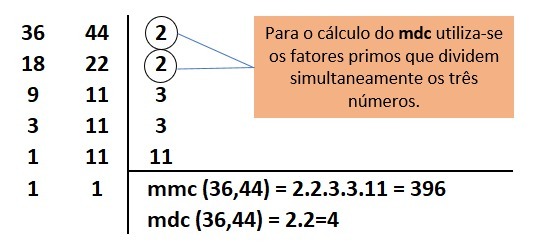
Exercise 3
Consider a number x, natural. Then classify the statements as true or false and justify.
a) The greatest common divisor of 24 and x may be 7.
b) The greatest common divisor of 55 and 15 can be 5.
a) No, because 7 is not a divisor of 24.
b) Yes, as 5 is a common divisor between 55 and 15.
Exercise 4
In a presentation for the launch of the new race car of the TodaMatéria team, an unusual race was held. Three vehicles participated: the launch car, last season's car and a regular passenger car.
The circuit is oval, the three started together and kept constant speeds. The launch car takes 6 minutes to complete a lap. Last season's car takes 9 minutes to complete one lap and the passenger car takes 18 minutes to complete one lap.
After the race starts, how long will it take for them to go through the same starting point together again?
To determine it is necessary to calculate the mmc (6, 9, 18).

So they went through the same starting point again 18 minutes later.
Exercise 5
In one confection, there are rolls of mesh measuring 120, 180 and 240 centimeters. You will need to cut the fabric into equal pieces, as big as possible, and there's nothing left. What will be the maximum length of each mesh strip?
To determine, we must calculate the mdc (120,180,240).

The longest possible length, without overhangs, will be 60cm.
Exercise 6
Determine the MMC and MDC from the following numbers.
a) 40 and 64
Correct answer: mmc = 320 and mdc = 8.
To find mmc and mdc, the fastest method is to divide the numbers simultaneously by the smallest possible primes. See below.

Note that mmc is calculated by multiplying the numbers used in factoring and gcd is calculated by multiplying the numbers that divide the two numbers simultaneously.
b) 80, 100 and 120
Correct answer: mmc = 1200 and mdc = 20.
The simultaneous decomposition of the three numbers will give us the mmc and mdc of the presented values. See below.
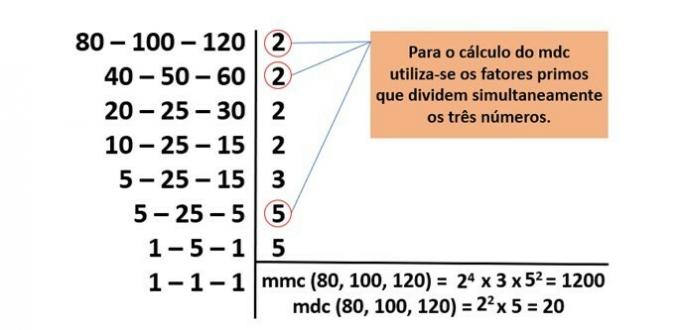
The division by the prime numbers gave us the result of mmc by multiplying the factors and mdc by multiplying the factors that divide the three numbers simultaneously.
Exercise 7
Using prime factorization, determine: what are the two consecutive numbers whose mmc is 1260?
a) 32 and 33
b) 33 and 34
c) 35 and 36
d) 37 and 38
Correct alternative: c) 35 and 36.
First, we must factor the number 1260 and determine the prime factors.
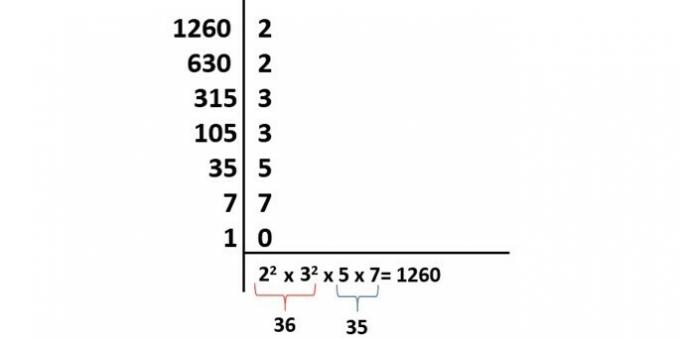
By multiplying the factors, we find that the consecutive numbers are 35 and 36.
To prove it, let's calculate the mmc of the two numbers.

Exercise 8
A scavenger hunt with students from three 6th, 7th and 8th grade classes will be held to celebrate Student Day. See below the number of students in each class.
| Class | 6º | 7º | 8º |
| Number of students | 18 | 24 | 36 |
Determine through the mdc the maximum number of students in each class that can participate in the competition as part of a team.
After that, answer: how many teams can be formed by the 6th, 7th and 8th classes, respectively, with the maximum number of participants per team?
a) 3, 4 and 5
b) 4, 5 and 6
c) 2, 3 and 4
d) 3, 4 and 6
Correct alternative: d) 3, 4 and 6.
To answer this question, we must start by factoring the given values into prime numbers.
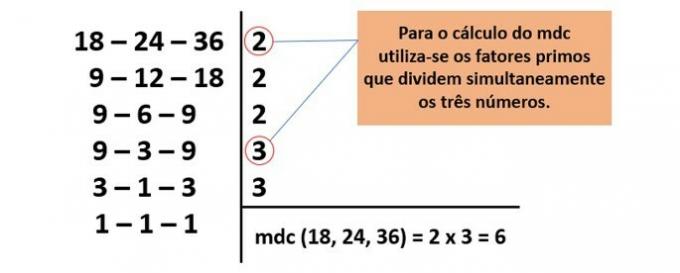
Therefore, we found the maximum number of students per team and, in this way, each class will have:
6th year: 6/18 = 3 teams
7th year: 6/24 = 4 teams
8th year: 36/6 = 6 teams
Entrance Exams Solved
question 1
(Apprentice Sailor - 2016) Let A = 120, B = 160, x = mmc (A, B) and y = mdc (A, B), then the value of x + y is equal to:
a) 460
b) 480
c) 500
d) 520
e) 540
Correct alternative: d) 520.
To find the value of the sum of x and y, it is first necessary to find these values.
In this way, we are going to factor the numbers into prime factors and then calculate the mmc and mdc between the given numbers.
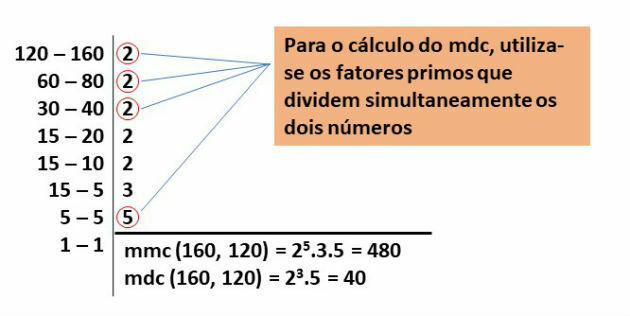
Now that we know the value of x (mmc) and y (mdc), we can find the sum:
x + y = 480 + 40 = 520
Alternative: d) 520
question 2
(Unicamp - 2015) The table below informs some nutritional values for the same amount of two foods, A and B.

Consider two isocaloric portions (of the same energy value) of foods A and B. The ratio between the amount of protein in A and the amount of protein in B is equal to
a) 4.
b) 6.
c) 8.
d) 10.
Correct alternative: c) 8.
To find isocaloric portions of foods A and B, let's calculate the mmc between the respective energy values.

So, we must consider the necessary amount of each food to obtain the caloric value.
Considering food A, to have a caloric value of 240 Kcal, it is necessary to multiply the initial calories by 4 (60. 4 = 240). For food B, it is necessary to multiply by 3 (80. 3 = 240).
Thus, the amount of protein in food A will be multiplied by 4 and that in food B by 3:
Food A: 6. 4 = 24 g
Food B: 1. 3 = 3 g
Thus, we have that the ratio between these quantities will be given by:
Alternative: c) 8
question 3
(UERJ - 2015) In the table below, three possibilities are indicated to arrange n notebooks in packages:

If n is less than 1200, the sum of the digits of the largest value of n is:
a) 12
b) 17
c) 21
d) 26
Correct alternative: b) 17.
Considering the values reported in the table, we have the following relationships:
n = 12. x + 11
n = 20. y + 19
n = 18. z + 17
Note that if we added 1 book to the value of n, we would no longer have a remainder in the three situations, as we would form another package:
n + 1 = 12. x + 12
n+1 = 20. x + 20
n+1 = 18. x + 18
Thus, n + 1 is a common multiple of 12, 18, and 20, so if we find the mmc (which is the smallest common multiple), we can, from there, find the value of n+1.
Calculating the mmc:
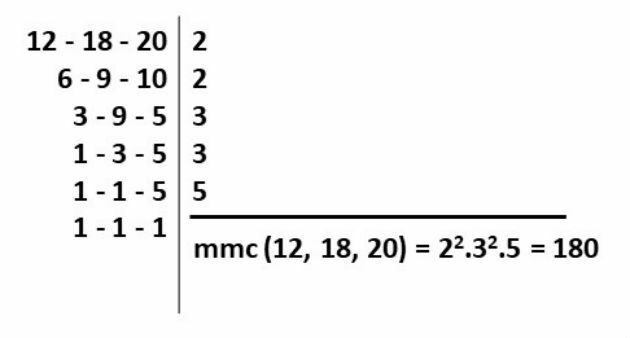
So the smallest value of n + 1 will be 180. However, we want to find the largest value of n less than 1200. So let's look for a multiple that satisfies these conditions.
For this, let's multiply 180 until we find the desired value:
180. 2 = 360
180. 3 = 540
180. 4 = 720
180. 5 = 900
180. 6 = 1 080
180. 7 = 1 260 (this value is greater than 1 200)
So we can calculate the value of n:
n + 1 = 1 080
n = 1080 - 1
n = 1079
The sum of its figures will be given by:
1 + 0 + 7 + 9 = 17
Alternative: b) 17
See too: MMC and MDC
question 4
(Enem - 2015) An architect is renovating a house. In order to contribute to the environment, he decides to reuse wooden planks taken from the house. It has 40 boards measuring 540 cm, 30 with 810 cm and 10 with 1080 cm, all of the same width and thickness. He asked a carpenter to cut the boards into pieces of equal length, without leaving leftovers, and so that the new pieces were as large as possible, but shorter in length that 2 m.
In response to the architect's request, the carpenter must produce
a) 105 pieces.
b) 120 pieces.
c) 210 pieces.
d) 243 pieces.
e) 420 pieces.
Correct alternative: e) 420 pieces.
As the pieces are asked to be the same length and as large as possible, let's calculate the mdc (maximum common divisor).
Let's calculate the mdc between 540, 810 and 1080:
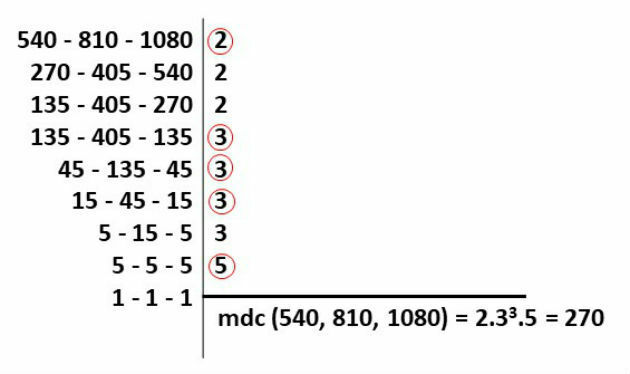
However, the value found cannot be used, as there is a restriction on the length to be less than 2 m.
So let's divide 2.7 by 2, as the value found will also be a common divisor of 540, 810, and 1080, as 2 is the smallest common prime factor of these numbers.
Then, the length of each piece will be equal to 1.35 m (2.7: 2). Now we need to calculate how many pieces we will have of each board. For this, we will do:
5.40: 1.35 = 4 pieces
8.10: 1.35 = 6 pieces
10.80: 1.35 = 8 pieces
Considering the quantity of each board and adding up, we have:
40. 4 + 30. 6 + 10. 8 = 160 + 180 + 80 = 420 pieces
Alternative: e) 420 pieces
question 5
(Enem - 2015) The manager of a cinema annually provides free tickets to schools. This year 400 tickets will be distributed for an afternoon session and 320 tickets for an evening session of the same film. Multiple schools can be chosen to receive tickets. There are some criteria for the distribution of tickets:
- each school must receive tickets for a single session;
- all eligible schools must receive the same number of tickets;
- there will be no leftover tickets (ie all tickets will be distributed).
The minimum number of schools that can be chosen to obtain tickets, according to the established criteria, is
a) 2.
b) 4.
c) 9.
d) 40.
e) 80.
Correct alternative: c) 9.
To find out the minimum number of schools, we need to know the maximum number of tickets that each school can receive, considering that this number must be equal in both sessions.
In this way, we will calculate the mdc between 400 and 320:

The mdc value found represents the largest number of tickets that each school will receive, so that there are no leftovers.
To calculate the minimum number of schools that can be chosen, we must also divide the number of tickets for each session by the number of tickets each school will receive, so we have:
400: 80 = 5
320: 80 = 4
Therefore, the minimum number of schools will be equal to 9 (5 + 4).
Alternative: c) 9.
question 6
(Cefet/RJ - 2012) What is the value of the numeric expression ?
a) 0.2222
b) 0.2323
c) 0.2332
d) 0.3222
Correct alternative: a) 0.2222
To find the value of the numeric expression, the first step is to calculate the mmc between the denominators. Thus:
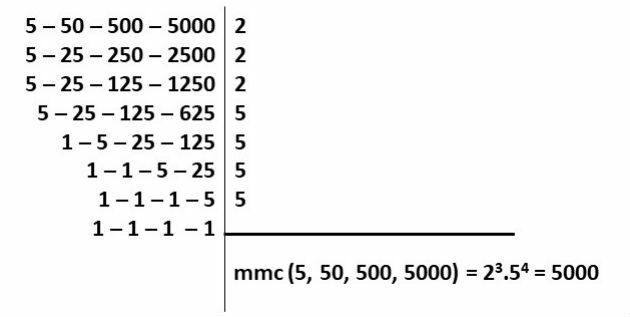
The mmc found will be the new denominator of the fractions.
However, in order not to change the fraction value, we must multiply the value of each numerator by the result of dividing the mmc by each denominator:
Solving the addition and division, we have:
Alternative: a) 0.2222
question 7
(EPCAR - 2010) A farmer will plant beans in a straight bed. To do this, he began marking the places where he would plant the seeds. The figure below indicates the points already marked by the farmer and the distances, in cm, between them.

This farmer then marked other points among the existing ones, so that the distance d among all of them was the same and the greatest possible. if x represents the number of times the distance d was obtained by the farmer, so x is a number divisible by
a) 4
b) 5
c) 6
d) 7
Correct alternative: d) 7.
To solve the question, we need to find a number that divides the presented numbers at the same time. As the distance is asked to be as far as possible, let's calculate the mdc between them.
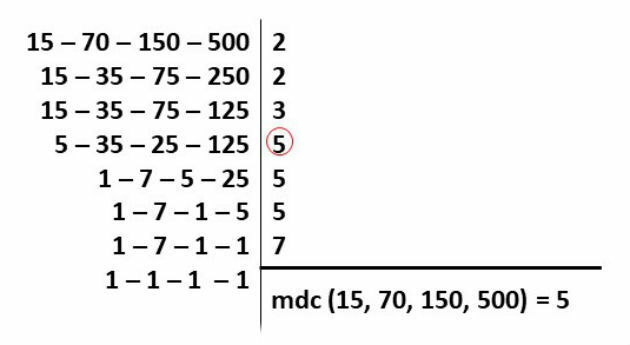
In this way, the distance between each point will be equal to 5 cm.
To find the number of times this distance was repeated, let's divide each original segment by 5 and add the values found:
15: 5 = 3
70: 5 = 14
150: 5 = 30
500: 5 = 100
x = 3 + 14 + 30 + 100 = 147
The number found is divisible by 7, since 21.7 = 147
Alternative: d) 7
See too: Multiples and Dividers


